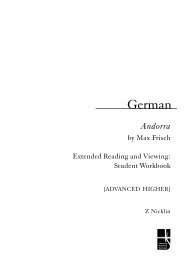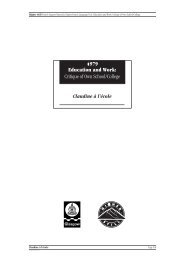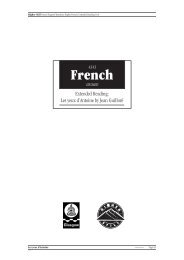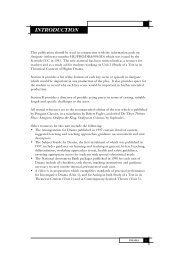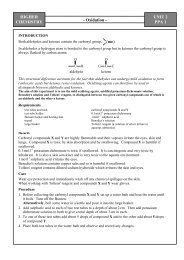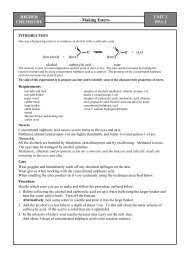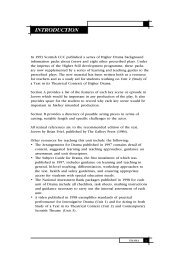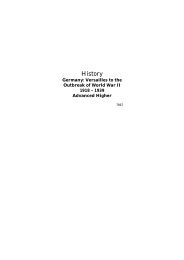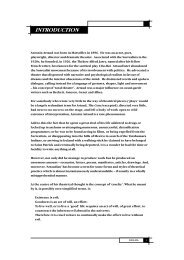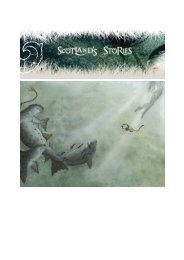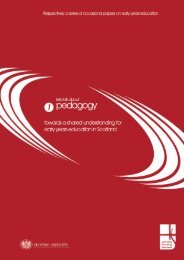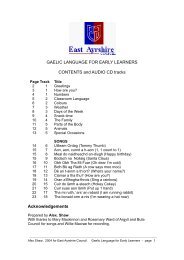RMPS - Int2/Higher - World Religions - Judaism - Education Scotland
RMPS - Int2/Higher - World Religions - Judaism - Education Scotland
RMPS - Int2/Higher - World Religions - Judaism - Education Scotland
Create successful ePaper yourself
Turn your PDF publications into a flip-book with our unique Google optimized e-Paper software.
Rosh Hashanah<br />
THE GOALS<br />
Rosh Hashanah is regarded as the birthday of the world, as it marks the<br />
anniversary of the day when God created man. Its names include Yom<br />
Ha’din (pr. ha-deen), the Day of Judgement, as this is when God judges<br />
people for their deeds of the previous year, and Yom Hazikaron (pr. hazee-ka-ron),<br />
the Day of Remembrance, as people remember their actions<br />
and deeds of the previous year. Rosh Hashanah lasts for two days.<br />
Like all Jewish festivals and Shabbat, prayers start with the evening<br />
service on the previous day. As people leave the synagogue, they greet<br />
each other with ‘Shana Tova’ (Happy New Year). This being the Jewish<br />
New Year many Jews will have sent Jewish New Year greeting cards to<br />
their family and friends beforehand.<br />
Preparation for Rosh Hashanah is very similar to Shabbat with the<br />
addition of a new fruit being bought. This fruit must be one that has not<br />
been tasted in the past year, e.g. a pomegranate. This symbolises<br />
renewal and a special blessing will be recited before eating it. Another<br />
popular observance during this holiday is eating apples dipped in<br />
honey, and honey cake. These are symbols of wishing for a sweet new<br />
year.<br />
Like Shabbat, Rosh Hashanah will be brought in by lighting candles, and<br />
no work is allowed on the festival. The prayers for Rosh Hashanah are<br />
read from a special prayer book called a machzor. The high point of the<br />
morning service is the blowing of the shofar. Unlike in Ellul when only a<br />
few notes are blown, on Rosh Hashanah a hundred notes are blown to<br />
warn the people and stir them to improve their moral behaviour and<br />
become closer to God. This is in accord with the command, ‘And in the<br />
seventh month, on the first day of the month; …it is a day of blowing the<br />
horn unto you’ (Numbers 29: 1).<br />
This explains why Rosh Hashanah is also called Yom Teruah (pr. te-rooah),<br />
the Day of the Sounding of the Shofar. The notes of the shofar<br />
represent the crying of one’s soul yearning to be reunited with God. If<br />
Rosh Hashanah falls on a Shabbat the shofar is not blown; since<br />
observing the Sabbath when musical instruments are not played<br />
(because it is considered to be work) is more important than blowing<br />
the shofar. It is also an object lesson in the importance of observing the<br />
Sabbath.<br />
Another custom of Rosh Hashanah is tashlich, which takes place after<br />
the afternoon service of the first day of Rosh Hashanah. This involves<br />
<strong>RMPS</strong>: WORLD RELIGIONS – JUDAISM (INT 2, H) 47<br />
© Learning and Teaching <strong>Scotland</strong>



